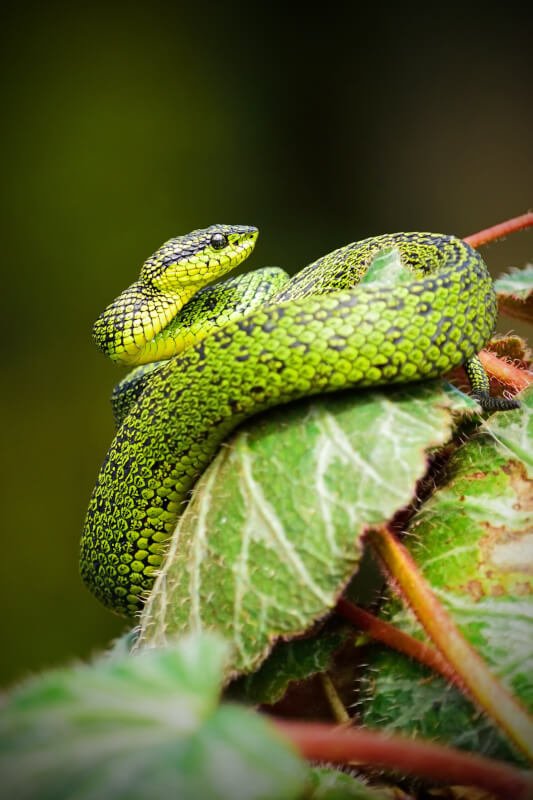In the exciting world of reptiles, it’s not uncommon to encounter an aggressive specimen from time to time. Whether you’re a reptile enthusiast or simply found yourself face-to-face with an irritable creature, knowing the best way to handle these aggressive reptiles is essential for your safety and the well-being of the animal. This article will provide you with valuable insights and practical tips that will help you navigate these encounters with confidence and ensure a harmonious coexistence with these fascinating creatures. So, get ready to unlock the secrets of handling aggressive reptiles like a pro!

Understanding Aggressive Reptile Behavior
Reptiles, despite their calm and mysterious demeanor, can display aggressive behavior under certain circumstances. It is crucial to understand the signs of aggression in reptiles to ensure your safety and the well-being of the reptiles themselves. By recognizing these signs and understanding the reasons behind their aggression, you can take appropriate measures to prevent and manage aggressive behavior effectively.
Recognizing signs of aggression in reptiles
Aggression in reptiles can manifest in various ways, including hissing, lunging, biting, tail whipping, and puffing up their bodies. It is essential to observe your reptile closely and become familiar with their usual behavior to distinguish aggressive behaviors from normal responses. Pay attention to any sudden changes in their body language, vocalizations, or defensive actions, as these may indicate aggression.
Understanding the reasons for reptile aggression
There are several reasons why reptiles may behave aggressively. One common cause is territoriality, as reptiles may defend their territory aggressively against perceived threats. Other factors that can contribute to aggression include fear, stress, hunger, discomfort, illness, breeding instincts, and improper handling or socialization. Understanding these underlying reasons will help you address the root cause of the aggression and take appropriate preventive measures.
Preventing Aggressive Behavior in Reptiles
While it is crucial to know how to handle aggressive reptiles safely, prevention is always better than intervention. By providing appropriate enclosures and habitat, ensuring proper nutrition and hydration, handling and socializing reptiles properly, and maintaining a regular routine while minimizing stress, you can significantly reduce the likelihood of your reptiles displaying aggressive behavior.
Providing appropriate enclosures and habitat
Reptiles require suitable enclosures that mimic their natural habitat. Ensure that the enclosure is of the correct size, provides appropriate temperature and humidity levels, offers hiding spots and basking areas, and contains the necessary substrate and furnishings. A comfortable and secure environment will promote a sense of security, reducing the likelihood of aggression.
Ensuring proper nutrition and hydration
Proper nutrition and hydration are vital for the overall health and well-being of reptiles. Make sure to feed your reptiles a balanced diet consisting of species-specific foods. Provide fresh water in a shallow dish or mist their enclosure to maintain adequate hydration. Malnutrition or dehydration can lead to stress and other health issues, potentially triggering aggression.
Handling and socializing reptiles properly
Handling reptiles requires proper technique and understanding of their species-specific needs and behaviors. Always approach the reptile calmly and confidently, avoiding sudden movements or loud noises that could startle them. Support their body properly, avoiding any excessive pressure or restraint. Socialization should be gradual and conducted in a controlled environment, allowing the reptile to acclimate to human interaction at their own pace.
Maintaining a regular routine and minimizing stress
Reptiles thrive on routine and consistency. Establishing a regular feeding, cleaning, and handling schedule will help reduce stress and promote a sense of security. Minimize any changes to their environment, such as rearranging their enclosure unnecessarily, or introducing unfamiliar objects or animals, as these disruptions can trigger stress and potentially aggressive behavior.

Safety Precautions for Handling Aggressive Reptiles
While prevention is key, there may be instances where you need to handle an aggressive reptile, such as during veterinary care or enclosure maintenance. It is crucial to take the necessary safety precautions to protect yourself and the reptile from harm. By assessing the risks beforehand, using protective equipment and tools, designating a handling area, handling reptiles with a partner, and knowing emergency protocols, you can ensure safe handling practices.
Assessing the risks before handling
Before attempting to handle an aggressive reptile, assess the potential risks involved. Consider the size, strength, and temperament of the reptile, as well as the environment in which you will be handling it. If the risks outweigh your experience or capabilities, it is best to seek professional assistance.
Using protective equipment and tools
Protective equipment, such as gloves, long sleeves, and sturdy footwear, can provide an added layer of safety when handling aggressive reptiles. Additionally, using appropriate tools, such as snake hooks or tongs, allows you to maintain a safe distance while still having control over the reptile. It is crucial to research and use the correct equipment for the specific reptile species you are dealing with.
Having a designated handling area
Creating a designated handling area within the enclosure or a separate space ensures a controlled environment for handling aggressive reptiles. This area should be clear of potential hazards and easy to access. By having a designated space, you can establish a routine and acclimate the reptile to the handling process more effectively.
Handling reptiles with a partner
Handling aggressive reptiles alone can be risky, so having a partner during the process is highly recommended. A partner can assist in maintaining control over the reptile, provide an extra set of eyes and hands, and offer support in case of emergency. It is essential to communicate effectively and coordinate your actions to ensure a safe and successful handling experience.
Knowing emergency protocols
Even with all precautions in place, emergencies can still occur. It is vital to be prepared and familiarize yourself with emergency protocols before handling aggressive reptiles. Have a plan in case of an escape or injury, know how to handle venomous bites or scratches, and be aware of the nearest emergency veterinary services. Being proactive and prepared can make all the difference in managing potential emergencies.
Techniques for Safely Handling Aggressive Reptiles
When it comes to handling aggressive reptiles, employing the right techniques is crucial for both your safety and the reptile’s well-being. By approaching the reptile cautiously, using the correct handling technique for the species, gaining the reptile’s trust, and reacting calmly to aggressive behaviors, you can minimize stress and handle the situation safely.
Approaching the reptile cautiously
Approaching an aggressive reptile should always be done with caution. Avoid sudden movements or loud noises that may startle or escalate their aggression. Move slowly and maintain a respectful distance until you can assess the reptile’s behavior and readiness for handling. By staying calm and cautious, you can help to prevent the reptile from feeling threatened or provoked.
Using the correct handling technique for the species
Each species of reptile requires a specific handling technique to ensure their safety and yours. Research and familiarize yourself with the proper handling method for the reptile species you are dealing with. Some reptiles may be best approached from the rear, while others may require support under their body or tail. Using the correct technique will minimize stress and risk of injury.
Gaining the reptile’s trust
Building trust with aggressive reptiles can help mitigate their aggression and make handling safer. Spend time near the reptile’s enclosure, talking softly or using a calm voice, allowing them to become used to your presence. Gradually introduce handling sessions, starting with short durations and rewarding them with treats or positive reinforcement to associate handling with positive experiences.
Reacting calmly to aggressive behaviors
In the event that a reptile displays aggressive behavior during handling, it is vital to remain calm and composed. Avoid making sudden movements or attempting to force the reptile into submission, as this can escalate the aggression. Instead, maintain a firm but gentle grip, provide steady support, and wait for the reptile to calm down before continuing. Patience and a calm demeanor can help defuse aggressive situations.

Dealing with Specific Aggressive Reptile Species
Different reptile species may exhibit unique aggressive behaviors, requiring tailored approaches to handling and management. Whether you are dealing with aggressive snakes, monitor lizards, geckos and iguanas, or tortoises and turtles, understanding their specific behaviors and needs will enable you to address their aggression effectively.
Handling aggressive snakes
Snakes, such as venomous species or those with a defensive nature, may display aggression if they feel threatened. When handling aggressive snakes, it is crucial to exercise caution and use appropriate tools like snake hooks or tongs to maintain control. Avoid handling venomous snakes unless you have the necessary expertise and experience, and if unsure, always seek professional assistance.
Managing aggression in monitor lizards
Monitor lizards, renowned for their strength and assertive behavior, may exhibit aggression due to fear or territoriality. When handling aggressive monitor lizards, it is essential to establish trust gradually and respect their boundaries. Use a firm yet gentle grip while supporting their body, keeping their mouth away from potential biting areas. Seek guidance from experienced reptile keepers or professionals for specific handling techniques.
Approaching aggressive geckos and iguanas
Geckos and iguanas, though generally docile, can become aggressive if they feel threatened or stressed. When dealing with aggressive geckos or iguanas, use a slow approach and allow them to acclimate to your presence. Never grab or restrain them forcefully, as this may exacerbate their aggression. Offering treats or positive reinforcement can help establish trust and positive associations with handling.
Addressing aggression in tortoises and turtles
Tortoises and turtles may display aggression, especially during mating or territorial disputes. When handling aggressive tortoises or turtles, it is crucial to avoid direct contact with their mouth, as they can be quick to bite. Use a calm and assertive approach, supporting their body properly, while avoiding any sudden movements or loud noises that may escalate their aggression. Consult with reptile veterinarians or experienced keepers for species-specific handling techniques.
Working with Professionals and Experts
Managing and handling aggressive reptiles can be challenging, and seeking advice from professionals and experts in the field is invaluable. By consulting experienced reptile keepers, herpetologists, and reptile veterinarians, you can access a wealth of knowledge and expertise on managing aggressive reptiles. Additionally, enrolling in reptile handling and education programs can provide you with the necessary skills and understanding to handle reptiles more confidently.
Seeking advice from experienced reptile keepers
Experienced reptile keepers possess practical knowledge and insights gained from years of working with different reptile species. Engaging with these individuals can provide valuable tips, guidance, and support in handling aggressive reptiles. Online forums, local reptile clubs, or visiting professional breeding facilities or zoos are great resources for connecting with experienced keepers.
Consulting herpetologists and reptile veterinarians
Herpetologists and reptile veterinarians are experts in reptile behavior, health, and management. Consulting these professionals can help you understand the underlying causes of reptile aggression and develop effective strategies to address it. They can also provide guidance on appropriate husbandry practices, handling techniques, and offer insights into specific reptile species.
Enrolling in reptile handling and education programs
Enrolling in reptile handling and education programs can provide structured learning opportunities and hands-on experience in managing and handling aggressive reptiles. These programs often cover topics such as species-specific behavior, safe handling techniques, and reptile husbandry. Whether it is a workshop, seminar, or a more comprehensive program, investing in education will enhance your knowledge and skills as a reptile keeper.

Addressing Aggression in Captive Reptiles
Aggression in captive reptiles can often stem from environmental factors or improper husbandry practices. Identifying and addressing potential problems in captive reptile environments, implementing behavior modification techniques, and seeking professional help for long-term aggression issues are critical in managing and mitigating aggression in captivity.
Identifying problems in captive reptile environments
Captive reptiles rely on their environment for comfort, security, and overall well-being. It is essential to regularly assess the reptile’s enclosure to ensure it meets their needs. Look for potential stressors, such as inadequate temperature or humidity levels, incorrect substrates, overcrowding, or lack of hiding spots. Addressing these issues promptly can reduce stress and minimize the likelihood of aggression.
Implementing behavior modification techniques
Behavior modification techniques can be effective in managing aggression in captive reptiles. These techniques involve positive reinforcement, reward-based training, and desensitization to reduce fear or stress-associated aggression. Consulting with behavior specialists or professionals with experience in reptile behavior can provide guidance on implementing these techniques tailored to your reptile’s specific needs.
Seeking professional help for long-term aggression issues
If aggression persists despite your efforts, seeking professional help is crucial. Chronic aggression may indicate underlying health issues or deep-seated behavioral problems that require expert intervention. Consult with reptile veterinarians or behavior specialists with experience in managing aggressive reptiles. They can conduct thorough assessments, recommend appropriate treatments or modifications, and provide ongoing guidance throughout the process.
Educating the Public about Aggressive Reptiles
Educating the public about reptile behavior and promoting responsible reptile ownership is essential to foster a better understanding and appreciation for these often misunderstood creatures. By creating awareness, providing educational resources and workshops, and promoting responsible reptile ownership practices, we can ensure the well-being of both reptiles and their human caretakers.
Creating awareness about reptile behavior
Many people hold misconceptions about reptile behavior, often associating aggression with malice or danger. By creating awareness through public campaigns, media outreach, and social media initiatives, we can help dispel myths and provide accurate information about reptiles’ natural behaviors. Highlighting the common signs of aggression and explaining the underlying reasons behind it can promote understanding and empathy towards reptiles.
Providing educational resources and workshops
Educational resources and workshops that focus on reptile behavior and responsible ownership are invaluable in educating the public. These resources can include brochures, pamphlets, online articles, and videos that provide information on reptile care, handling techniques, and aggression management. Collaborating with local schools, libraries, or community centers to host workshops and presentations can further reach and inform the public.
Promoting responsible reptile ownership
Promoting responsible reptile ownership practices can play a significant role in reducing aggression and ensuring the overall welfare of reptiles. Encouraging prospective reptile owners to research and understand the specific needs and behaviors of the reptile species they are interested in can prevent situations where aggression arises due to improper care. Emphasizing proper enclosure setup, nutrition, socialization, and veterinary care promotes responsible ownership.

Legal Considerations for Handling Aggressive Reptiles
Handling aggressive reptiles may have legal implications depending on your location. It is essential to be aware of local and regional laws regarding reptile ownership, handling, and transportation. Additionally, obtaining proper permits and licenses, and understanding liability and insurance requirements are crucial aspects of responsible reptile management.
Checking local and regional laws
Laws regarding reptiles can vary significantly based on where you reside. Research and familiarize yourself with the laws and regulations specific to your location. This includes ensuring compliance with permits, licenses, and any restrictions related to reptile ownership, handling, or transportation. Staying informed will help you avoid legal issues and promote responsible reptile management.
Obtaining proper permits and licenses
In some areas, certain reptile species may require permits or licenses to own or handle legally. These permits are typically in place to protect endangered species, prevent the release of invasive species, or ensure that owners have the necessary knowledge and expertise to care for the reptile properly. Familiarize yourself with the requirements and obtain any necessary permits or licenses to stay in compliance with local regulations.
Understanding liability and insurance requirements
Handling aggressive reptiles carries inherent risks, and it is essential to understand liability and insurance requirements. Liability insurance can provide financial coverage in case of injuries caused by your reptile, whether to yourself, others, or property. Consult with insurance providers to determine what coverage is necessary and ensure you are adequately protected.
Conclusion
Handling aggressive reptiles requires knowledge, understanding, and proper techniques to ensure the safety of both the handler and the reptile. By recognizing signs of aggression, implementing preventive measures, taking safety precautions, using appropriate handling techniques, and seeking professional expertise when needed, you can effectively manage and mitigate aggressive behavior in reptiles. Educating the public, promoting responsible ownership, and adhering to legal requirements are essential components of responsible reptile management. With proper care, attention, and understanding, aggressive behavior in reptiles can be effectively addressed, allowing for a harmonious coexistence between humans and these fascinating creatures.


